Pools on the way for Regional Aquatic Centre
Citizen of the Year Awards
AND MUCH MORE

Yamba community hub construction underway

Pools on the way for Regional Aquatic Centre
Citizen of the Year Awards
AND MUCH MORE

Yamba community hub construction underway
Welcome to the seventh edition of Clarence Magazine, highlighting the work that has been carried out in Quarter 3 of 2023-2024 as outlined in Council’s Operational Plan
I always find it to be a pleasure and a privilege to meet with people throughout the region, to hear what is important to individuals and their communities.
It’s also great to see the work that is being done for our community, to see first-hand how projects are making a difference in people’s lives.
Many kilometres of our local and regional roads throughout the region have been dramatically improved in recent months, from the back roads around Ulmarra to the urban streets of Maclean and Yamba, out to the Clarence Way from Mountain View to Copmanhurst, Baryulgil and beyond.
It has also been exciting to see work progressing on the new Regional Aquatic Centre, which is ontrack to be completed by Christmas this year. I’m sure many will be keen to try out the new pools

PICTURED: Mayor Peter Johnstone enjoys a chat at the On Record Seniors Week event at the Grafton Library.
Front cover image: An aerial view of the Clarence River at Yamba.

as the hot weather returns.
Work has also continued to replace our aging timber bridges with more resilient concrete structures to strengthen the connections between our communities into the future.
There has also been much happening to strengthen our social connections. I was thrilled to take part in our On Record Seniors Week celebrations at the Grafton library, where I was one of many to enjoy the impressive entertainment by our own local seniors, while chatting and enjoying one another’s company.
I was also given the privilege of presenting the Clarence Valley Citizen of the Year Awards in January. It is truly inspiring to hear the stories of these incredible locals who contribute so much to their communities, working tirelessly for the benefit of others. I know they are but a few of the countless many doing such great work in our local area, and I would like to extend my gratitude to all those who contribute to making the Clarence Valley the amazing place that it is.
Prior to the awards, I also welcomed our newest citizens to officially call Australia home. I too have been an outsider moving to Australia, and it was a pleasure to extend the warm welcome that I myself experienced in becoming part of the Clarence Valley community.
I hope you will enjoy what you read.
We acknowledge the Bundjalung, Gumbaynggirr and Yaegl people as the Traditional Owners of the land on which we live and work. We honour the First Nations peoples culture and connection to land, sea and community. We pay our respects to their Elders past, present and emerging.
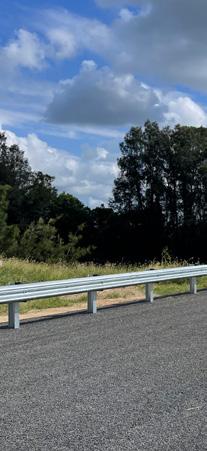
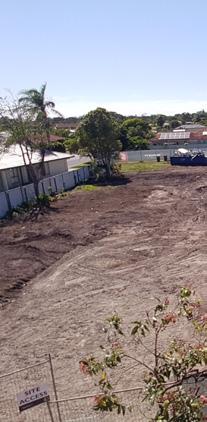





Welcome to Volume 7 of Clarence Magazine. As always, in the January – March period our Open Spaces teams are incredibly busy trying to get on top things. The combination of rain and sun during this period unfortunately, does not equate to a doubling of our resources. So while we appreciate you letting us know the grass, parks and gardens are looking a bit unkempt during this period (reports up 600%), our teams are already working to full capacity. It’s pleasing to hear your compliments as well – thanks for the vote of support Lower Clarence Scottish Society who let us know Maclean looked fantastic in readiness for the Highland Gathering over the Easter weekend.
Make sure you say hello to Brendan and the Town and Village Beautification Team, Jessie, John and Angus when you see them out and about in the coming months. As you’ll see in page 5, the team brings together a range of skills to target improvements beyond the scheduled maintenance activities we already conduct.
There’s been great community contribution towards preparation of the Active Transport Strategy. An adopted Active Transport Strategy opens doors to grant opportunities like those secured to deliver the safer school zones, Coutts Crossing school crossing being an example.
You’ll see in this volume like those before it, there has been a concentrated effort to improve road condition around the Valley, the latest list of repairs is featured in this magazine along with many other flood resilience infrastructure projects and land slip repairs.
On page 11, you can see the performance of Clarence Valley Council in delivering our ambitious State funded disaster recovery program. We aimed to deliver it in two years, 2023/2024 being the first of those and we are well on track with over 50% completion rate. This is largely thanks to the engagement of a skilled and experienced project management team that has led everything from design to contract management to delivery on the ground.
One of two bridges washed out following the 2022 storm and flood event and the only concrete one to be replaced in the Clarence Valley, the Wilcox Bridge has been built back stronger to be more resilient during events and is finally open to traffic. It is one of a number of bridges under construction in the Valley, all others being timber bridge replacements.
Jumping ahead in the magazine, it’s great to see progress on Treelands Drive Community Centre within the Yamba

Community Precinct. And how interesting to know that only 3% of material was disposed of to landfill following demolition. Construction is on budget and on time. As it is also with the Regional Aquatic Centre, we will be swimming in December.
It was a fantastic honour to attend the Clarence Valley Citizen of the Year Awards, and I was extremely proud of two of our own staff nominated by community for the work they do in community. A stark reminder that Clarence Valley Council staff are residents and community members too.
The magazine doesn’t really cover the backroom work that goes on in our organisation and it would be remiss of me not to mention the extraordinarily busy time we’ve had on the inside. There’s a lot of work goes into preparing the Operational Plan including Capital Works Program and Budget for the following year. In fact, almost half of our year is spent in this planning phase and we usually start in December each year. It is however, dependent on completion of the prior years Annual Financial Statements, and the February 2024 extension granted by the Audit Office, has impeded resourcing of preparation for next year. This year however, an enormous amount of work was conducted in February and March to put us in a position to present draft documentation to Council and community in April.
Volume 7 is another great read, if you are interested in what your Council has been doing over the past three months. Enjoy.
A new multiskilled team has been put together to target maintenance of town and village main streets.
The Town and Village Beautification Team’s boots hit the ground in recent weeks, bringing a wide range of skills and experience to the job.
Jessie is a landscaper and horticulturalist who is no stranger to working to high expectations, with a resume that includes care of the Old Parliament House Gardens.
John is a jack-of-all-trades with extensive experience in civil
construction, facilities maintenance and landscaping. Footpaths, culverts, parks and gardens – you name it he’s either built it or fixed it.
Angus is the apprentice, but he’s far from a rookie with a horticulture qualification and experience working on one of the southern hemisphere’s largest macadamia farms.
Brendan is a plumber with experience in contract and project management, who already knows the ropes within Council and will be now applying his skills to the new role in the town and village beautification team.
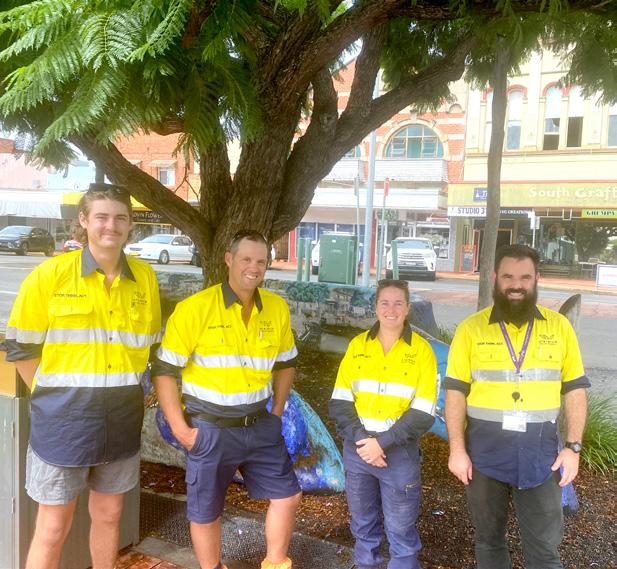
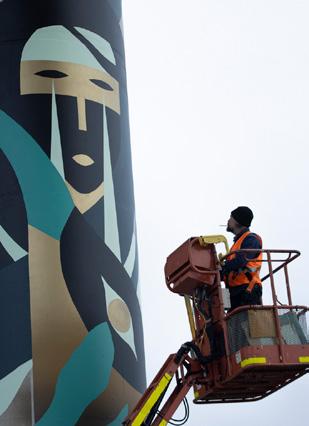
The Valley’s commemorative flood artworks have been recognised on a national level, taking out a silver medal in the Australian Street Art Awards.
The Australian Street Art Awards showcase destinations around the country where visitors can see worldclass public art, while recognising excellence in cultural tourism promotion.
This year, the Clarence was plunged into the national spotlight when it took out the silver in the Best Monument or Memorial category.
The project completed last year included larger-than-life artworks on the Lawrence reservoir and Harwood Bridge pylons, as well as 20 murals installed on planter boxes in Prince Street Grafton.
It has been widely promoted through social media, as a street art trail destination, and the Lawrence reservoir has featured as part of the Australian Silo Art Trail.
PICTURED: Above, Al Stark creating his painting on the pylons under the Harwood Bridge, depicting four female river sentinels and embodying the stories and dreaming of river and sea.

Far more people will be walking or riding a bike to get around the Clarence Valley in 20 years time thanks to a new and improved network of footpaths, bike lanes and safe road crossings.
This is the vision of the 2024-2044 Active Transport Strategy – to make it easier for you to put down the car keys, grab your walking shoes or jump on your bike to get around town.
That means you’ll be able to stay active and healthy, do your bit to protect our environment, and spend less money at the petrol pump.
New and improved footpaths, bike lanes and road crossings will also make it easier for our seniors, families, children and people with a disability to get out and about and enjoy the great outdoors.
The actions of the plan are a direct outcome of your thoughts and ideas that were received in 2023 during face-to-face sessions, and though surveys, emails, and letters.
In March this year the draft was put out for community feedback. Once the feedback has been considered, the plan will be officially adopted and work will begin on achieving its goals.
Create more safe places to cross the road
Connect gaps in pedestrian routes
Provide more shade, rest areas and access to drinking water
Improve signage and public awareness of paths and crossings
VIBRANT AND PRODUCTIVE STREETS
EFFECTIVE RESPONSES TO CLIMATE CHANGE LOWER TRANSPORT COSTS $
ACCESSIBLE FOR PEOPLE OF ALL ABILITIES SAFER STREETS
REDUCED DEMAND AND FRUSTRATION ASSOCIATED WITH CAR PARKING
HEALTHIER AND MORE ACTIVE COMMUNITY


It’s safer to walk across busy Armidale Road outside Coutts Crossing Public School, thanks to a new crossing.
Kids and families can now use the new crossing when walking to and from school. The raised concrete entry and exit points also provide a physical barrier between pedestrians and cars and are
brightly painted so drivers know to slow down and get ready to stop.
Opposite the school, there’s a new footpath so you don’t have to walk through mud when it’s raining.
Drop-offs and pick-ups are also easier, with a new marked carpark created on the school side next to the crossing, including a dedicated disability space.
Work has started on a project that will make it safer and easier to get around on Spenser Street, Iluka.
Soon you will be able to ride and walk along a two-metre-wide shared path, which is being built between Iluka Public School and the boat ramp, where it also gets very busy with people using the ferry to and from Yamba.
Walking across busy Riverview
Street will also be safer when the new crossing is completed.
Driving along Spenser Street is also being made safer and easier, by widening the road and improving drainage at the Micalo and Riverview Street intersections.
The $725,000 project is funded by the Federal Government Black Spot Program.
Driving along the Clarence Way between Mountain View and Louisa Creek is safer and smoother, now that an eightmonth program of flood recovery repair works has been completed.
Approximately 18 kilometres of damaged road has been dug up and rebuilt – an area covering roughly the same as 10 rugby fields.
Most of the work was funded by flood recovery grants from the State and Federal governments.

18km OF ROAD REPAIRED


16,000t OF ROAD BASE IMPORTED (DGB20)
100,000m2 TOTAL AREA REPAIRED
1300t BINDER (SLAG LIME)
Yamba Road is being lit up at night as crews work on repairing damaged patches between Palmers Island into Yamba.
Work is being done at night, so you won’t have to wait if yours is one of the 10,000 trips taken along the
busy road each day.
The section from Romiaka Bridge to Shallow Channel hasn’t been patched as it has been redesigned to be rebuilt later in the year, to make it wider, higher and less likely to be cut by floodwater.

Surrounded by waterways, Watts Lane at Harwood Island was just one of many local roads hard hit by flooding and heavy rain across the region in 2019 and again in 2022, racking up a multi-million-dollar damage bill.
Road repair crews have been flat out since the start of the financial year, working to restore these flood-affected roads – thanks largely to around $35 million through the Federal and State

Government Disaster Recovery Funding Arrangements.
Around 40 bitumen-sealed local roads have been repaired across the Clarence Valley since June 2023, including nine from January to March this year, with work continuing.
Among the roads repaired since January this year was Watts Lane – a vital route for transporting cane and quarry materials, which required significant reconstruction.

PICTURED: Flood damage on Watt Lane at Harwood (above left) under repairs in March (above rght). It was hard-hit by flooding as it is surrounded by waterways including the Clarence River, North Arm, Serpentine Channel and Nyang Creek.
Multiple sections of Avenue Road have been repaired since January as part of flood recovery work. Avenue Road connects Deep Creek Road near Tucabia, to Eight Mile Lane near Glenugie, and is also used to access the Clarence Correctional Centre.
LATEST LOCAL ROADS REPAIRED INCLUDE:
Fischers Rd, Chatsworth
Watts Ln, Harwood
Morpeth St, Harwood
North Arm Chatsworth Road.
Possum Hole, Ulmarra
Avenue Rd, Ulmarra
Sherry’s Ln, Calliope
Lake Rd, Swan Creek
Four Mile Rd, Swan Creek
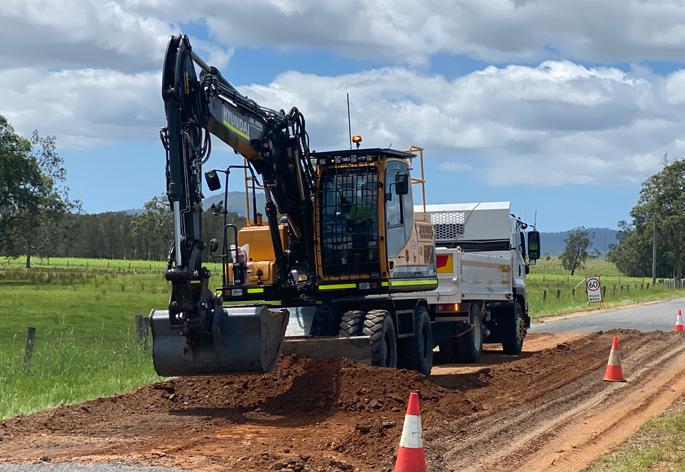
Ashby residents at the end of Patemans Road now have a better connection to town that’s less likely to flood.
A 300-metre section of dirt road that had been prone to getting washed out has been rebuilt higher and sealed with bitumen to make it more resistant to damage.
Importantly, the old single 525-millimetre pipe under the road was replaced with a much larger culvert consisting of three 1200-metre pipes, to ensure that stormwater could flow through without backing up over the road.
In addition to giving residents a more reliable access road in wet weather, the project will reduce ongoing maintenance costs.
The job came in under budget and was paid for by the Federal and State Governments’ Disaster Recovery Arrangements.
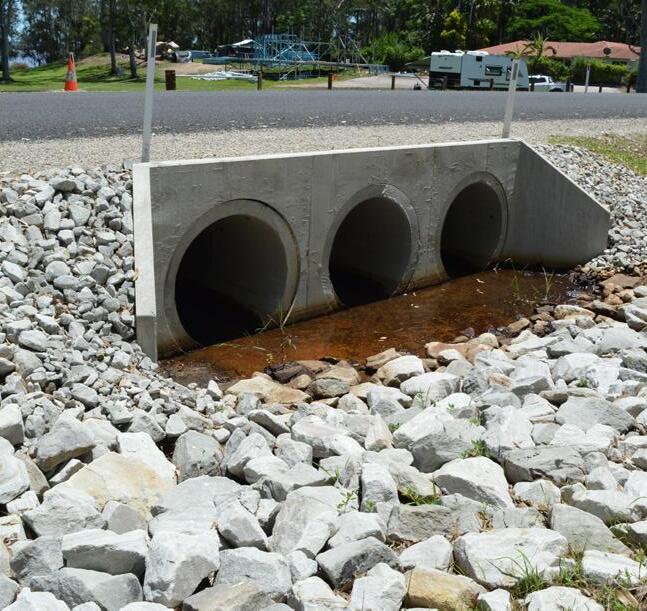
680% INCREASE IN CULVERT CAPACITY
300m DIRT ROAD BITUMENT SEALED
$600k GOVERNMENT FUNDING


EYES IN THE DRAINS
CCTV cameras have been sent down the stormwater drains around Yamba to make sure they’re clean and clear. Any blockages detected will then be cleared. It’s the same thing that was done in Iluka last year, which resolved issues with rainwater building up in some residential areas.


PICTURED: (Left) Civil Services Manager Devin Simpson (second from right) has worked closely with a wide range of teams to deliver a high rate of completed flood recovery works, including local design partners Bridge Knowledge and project management consultants BASEC Engineering, and (right) Council’s own road grading crews.
More capital works projects are being completed in the Clarence than anywhere else on the Northern Rivers in the wake of the devastating 2022 floods, according to the latest report card from the Northern Rivers Reconstruction Corporation.
The report showed that as of January this year, 137 projects had been completed, which is just over half of the 270 projects scheduled.
The $76 million in work completed so far has included restoration of more than 100 kilometres of damaged roads; replacement of washed-out culverts and drains; and rebuilding a destroyed concrete bridge.
The result was down to the coordinated efforts of many different teams and people inside and outside of Council, according to our Civil Services Manager, Devin Simpson.
“Delivery of work on the ground has involved a lot of planning to make sure all the different parts of the machine work together efficiently, to reduce gaps between phases of project development and delivery,” he said.
“This has included cooperation between various teams and sections within Council, external project managers, and many individual local contractors.”
And of course, none of the work would have been possible without the expertise of staff and many hours of work put into applications for government
This funding has included more than $113 million secured so far through the Federal and State Governments’ Disaster Recovery Funding Arrangements (DRFA).

PICTURED: Looking out over a job well done at
A
peek inside the art of creating perfect sports fields
There’s nothing more satisfying to John Causley than standing back to admire a freshly prepared sports field. It’s an art he’s been refining for more than 20 years, and there’s a lot more to it than sitting behind the wheel of any old ride-on mower.
Each of the Clarence Valley’s fields is prepared differently depending on what it’s going to be used for – this is where John’s experience and knowledge comes in.
In recent months, hot wet weather has meant rapid grass growth, adding to the challenge.
Summer cricket grounds are manicured at 16mm in length (a few millimetres longer if the weather is hot and dry).
A special finishing mower is used –razor-sharp blades spin on the mowing deck’s cylinders to cut with precision and create an ultra-smooth surface.

Passes are made in an alternating pattern, which bends the grass and creates the distinctive chequered appearance.
The result is a fast-paced game of cricket on a field that plays well.
Winter rugby grounds, on the other hand, are oversewn with rye grass and cut longer (25mm to 32mm). The result is a spongier surface and a more cushioned landing for players who frequently hit the ground in tackles and scrums.
The heavier grass off-field is tackled with rugged machines like slashers, where creating a playing surface isn’t a factor and it’s more about getting through lots of work efficiently.
And then there’s different machinery and techniques for golf fairways and greens, hockey fields, soccer, multiuse fields, and special machines for boggy or steep terrain...
Remote control mowing technology is helping us tame grass growth in hard to access locations.
The mower nick named The Bear (pictured) utlises tracks for maximum stability in muddy terrain, particularly after flooding.

When John isn’t winning Goanna Pulling competitions at Wooli, setting one-arm push up records, or creating adventures for his online fishing channel, he’s in charge of maintaining the Clarence Valley’s sporting fields.
He grew up among the cane fields at Palmers Island and became a greenkeeper at just 17 years of age, a job he continues to love to this day.
A special growth retardant is applied to sports fields during summer to reduce the need for mowing. Less fuel is used, and machines need less maintenance, so it saves money and reduces carbon emissions.
Another of the team’s remote control monsters, The Spider, has been designed with features such as all wheel drive and a powerful motor to enable it to navigate steep inclines that would pose a risk of overturning and injury using a traditional ride-on or tractor.
Go for a drive along Four Mile Lane (off Big River Way near Grafton) and you’ll now be able to get across Swan Creek without the need for a detour, thanks to the brand new, $3.7 million Wilcox Bridge.
It’s especially good news for residents, who have had to find another way to get around for the past two years since the old bridge was destroyed in the 2022 floods. They’ll now get back to driving a more direct route to town and home again, saving time and money.
The 50-metre, two-lane Wilcox Bridge was one of the first bridges in the region to be rebuilt since the floods. It involved many different experts and teams from design to completion, including local subcontractors. The project was paid for by the State and Federal Governments, after Council successfully applied for a grant through the Disaster Recovery Funding Arrangements.

Scan or tap the QR Code to watch how Wilcox Bridge materialised from start to finish.
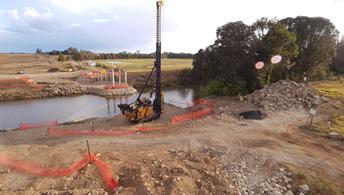
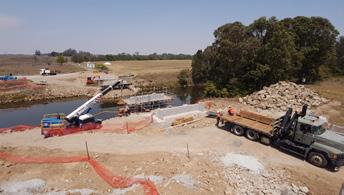
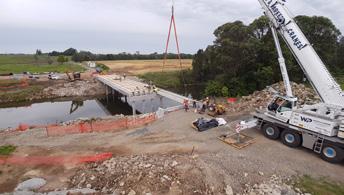

The 19 beams supporting the deck were manufactured to be stronger and lighter, by reinforcing them internally with high tensile, tensioned steel cables. This style of reinforced concrete is referred to as being ‘prestressed’.
1 The existing road is pulverised, mixed and levelled.
2 The piers start to take shape.
3 Concrete deck beams are lowered into place by crane.
4 The deck is poured and allowed to cure.
5 The completed bridge, opened to traffic on 27 February 2024.



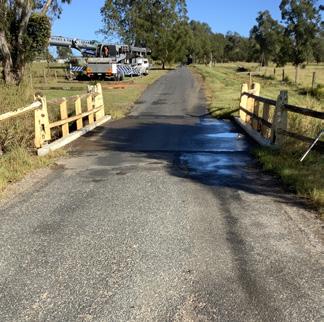
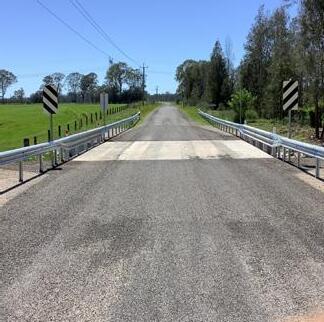
Work is continuing to replace ageing timber bridges with concrete in three more remote locations. New bridges currently under construction include the bridges at Old Glen Innes Road Dalmorton, Brennans Road Glenreagh, and Franklins Road Pillar Valley.
Scan or tap the QR code to keep up to date with progress on the Fixing Country Bridges Program

Residents and farmers in floodprone areas around Coutts Crossing and Whiteman Creek now have a much more reliable connection to town thanks to two new, bigger and better bridges.
The narrow old single-lane timber bridge over McIntosh Creek, on Black Swan Drive near Coutts Crossing, has been replaced with a dual-lane
concrete structure to enable vehicles to pass in both directions.
It’s also been built higher than the old bridge, so residents and farmers around Levenstrath and Braunstone are less likely to get cut off in floods. Concrete is also more resistant to damage in bushfires.
Likewise, the new concrete bridge over Fortis Creek, on Greberts Road
Whiteman Creek, provides a more flood and bushfire resilient link to town, for users such as residents and farmers. The old timber bridge was significantly deteriorated and required frequent inspections and maintenance.
Both bridges, with a total cost of just over $1.1 million, were funded by the NSW Government’s Fixing Country Bridges program.


Rescue tubes are now on hand at eight of our most popular local beaches and swimming holes to help save lives.
The rescue devises are housed in specially designed boxes, installed in selected locations to ensure they are available 24 hours a day should anyone need to be saved from the water.
The box includes directions and illustrations on how to use a rescue tube.
THE RESCUE TUBE BOXES LOCATIONS:
Clarence Head (Turners Beach)
Yamba Main Beach
Yamba Point (Lovers Point)
Pippi Beach
Angourie Blue and Green Pools
Brooms Head Main Beach (north)
Wooli Main Beach
Wooli Wall
PICTURED: The rescue tube box at Turners Beach Yamba – one of eight installed at popular swimming locations in the Clarence Valley to help save lives.
Three coastal villages are now better prepared to respond to lifethreatening heart attacks, as the result of our partnership with Iluka Rotary and local businesses.
A total of 20 automated external defibrillators (AEDs) have been installed in public areas across Iluka, Woody Head and Woombah as the result of efforts by the Rotary Club and businesses.
Council’s part in the project was to design and install signage around the villages to make sure the life saving devices could be easily located in an emergency.

has been installed around Iluka, Woody
and Woombah to make sure it’s easy to locate new defibrillators if someone is having a heart attack.

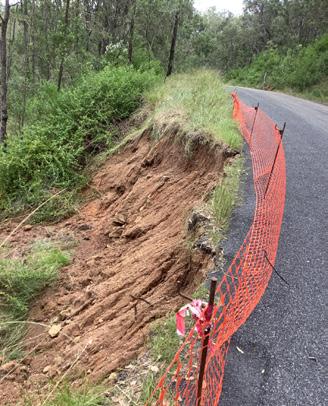
NUMBER OF LAND SLIPS: TWO
ESTIMATED COST OF REPAIRS: $1M
LOCATION: CLARENCE WAY, 70KM AND 100KM NORTH-WEST OF GRAFTON
FUNDING SOURCE: FEDERAL/ STATE DISASTER RECOVERY FUNDING ARRANGEMENTS
PROJECT STATUS: COMMENCED
WHO’S PAYING FOR IT?
Excavators, rollers and trucks are busy rebuilding two large chunks of hillside that were washed away along the Clarence Way during heavy rain in 2022.
At the first site known as 18 Mile, work has commenced to rebuild a 30-metre section of hillside and sealed road that was significantly damaged by the shallow land slip.
The slope is being dug out to form a staggered foundation with fill brought in and compacted on top to make the repairs stable and resistant to future
damage. Drainage improvements and revegetation is also being done to prevent erosion.
The second land slip, at Louisa Creek, was about 16 metres long and resulted in a steep drop of four metres next to the road. Compacted rock is being used instead of normal fill, to add extra strength and stability because of the depth of repairs.
The $1million cost is being covered by the State and Federal Governments' Disaster Recovery Funding Arrangements.
A Schedule of Works is included in Council’s weekly email newsletter Noticeboard to update residents on where and when road maintenance activities are taking place across the Valley. Scan or tap the QR code or visit www.clarence.nsw.gov.au/Noticeboard to subscribe.

The Commonwealth Disaster Recovery Funding Arrangements (DRFA) provide funding to the NSW Government for the Essential Public Asset Restoration Works (EPARW), delivered by local councils.
So far, $113 million has been secured for flood recovery work locally through the program, towards an estimated total flood damage bill of around $144 million.
Scan or tap the QR code to find out more about DRFA EPARW

More than 60 land slips have damaged the steep hills either side of a 60-kilometre stretch of the Old Glen Innes Road as the result of torrential rain and flooding in 2022. Funding of $19 million in government disaster recovery funding has been secured to pay for repairs, and work scheduled to start in mid-2024. The work is expected to take around a year.
Specialist engineers have been brought in, to design repairs for the 13 largest slips that are up to 43 metres long and six metres deep. These alone will cost around $10 million.
While the Old Glen Innes Road is no longer the main linkage between Grafton and Glen Innes, it is frequently used by locals and visitors to access natural areas for activities such as camping and fishing.
PICTURED: Just a few of the 61 land slips along a 60-kilometre section of the Old Glen Innes Road, that will be repaired using $19 million in government funding.
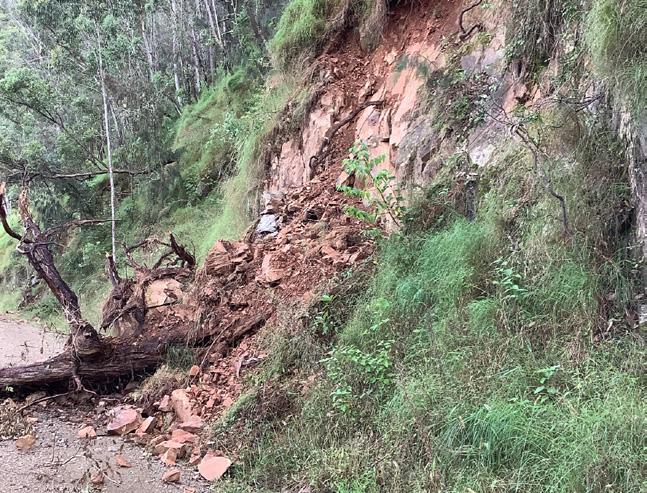

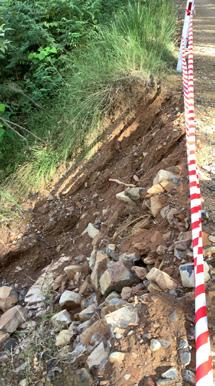

NUMBER OF LAND SLIPS: 60
ESTIMATED COST OF REPAIRS: $19M
FUNDING SOURCE: FEDERAL/STATE DISASTER RECOVERY FUNDING ARRANGEMENTS
PROJECT STATUS: UNDER DESIGN, COMMENCE MID-2024
Specialist engineers are designing repairs to the largest slips, which require much more work to ensure they are stable and long-lasting.
THE BASIC STEPS WILL BE:
Install self-drilling ‘micro-piles’ vertically into the rock bed
Pour concrete to tie the piles together and form a solid foundation
Install a ‘gabion’ rock and wire retaining wall, secured to the foundation
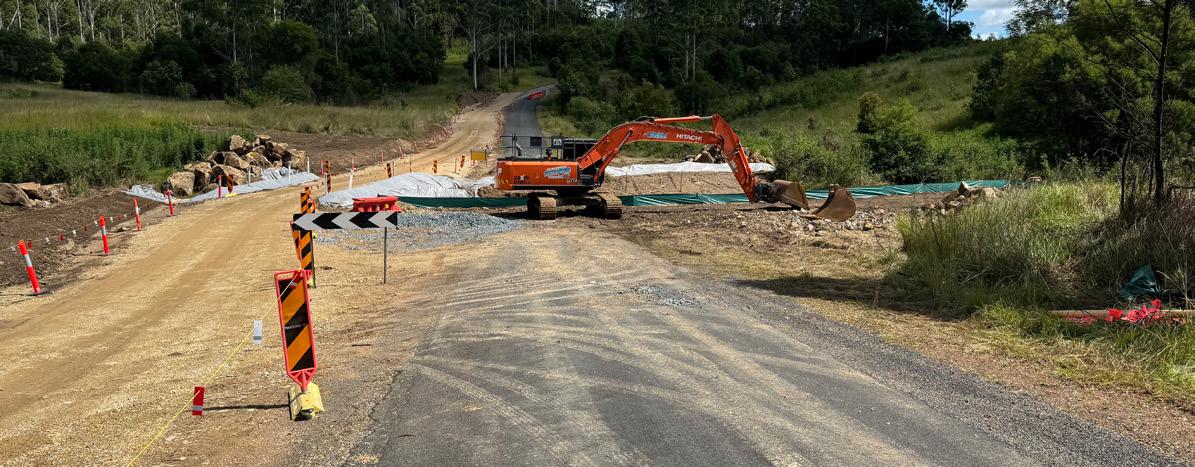
Repairs are underway on a flooddamaged causeway on Tullawudja Creek Road at Glenreagh.
The concrete over the pipe culverts on the downside of the road was washed away during flooding in 2021, leaving just five metres of causeway for use by vehicles that include the school bus and trucks carting timber to and from the local mill.
The causeway is being rebuilt and a new box culvert installed that is twice the size of the old one so it will be able to cope with much larger volumes of water during heavy rainfall, with extra rock armouring around the entry and exit to prevent erosion.

PICTURED: A causeway has been severely damaged by flood (above). Work has commenced (top) to repair the road and install a larger culvert to allow greater volumes of water through without causing damage. Access has been maintained through creation of a temporary sidetrack.
Work has started on a project to increase our capacity to supply clean drinking water.
A second clarifying lagoon is under construction at the water treatment plant in South Grafton, that will enable enough drinking water to be produced in a single day to fill 10 Olympic swimming pools.
As a result, daily production capacity will be greater than peak daily usage in summer, meaning reservoirs will be able to be kept topped up even when water consumption is at its highest.
The lagoons work by reducing particles (generally dirt) in the water that comes from the Nymboida River or Shannon Creek Dam, before it’s pumped to the reservoir and treated with chlorine.
The new lagoon is in addition to the one constructed last year.
High rainfall event causes turbidity (particles) to increase in raw water
Clarifying pond brought online
Approved coagulant added
Suspended particles bind together and settle to bottom
Clarified water pumped to 100ML reservoir

PICTURED: Construction has commenced on a second clarification lagoon to add to the one we have already (pictured), to increase capacity to supply clean drinking water.
A lot has changed since the first agreement was formed between the Clarence and Coffs Harbour 20 years ago on how water would be shared from the Nymboida River and Shannon Creek Dam.
The two Councils are currently in ongoing discussions to create a new, current and practical agreement, looking at how we share water as well as the cost and responsibilities of maintaining infrastructure.
Planning has begun to enable installation of a permanent water filtration facility at Glenreagh, to replace the current temporary unit.
Work is underway to rezone the proposed Crown land location and undertake a Review of Environmental Factors, required to proceed with the project.
Tenders are anticipated to be called around mid-2024 for the Glenreagh facility, as well as an upgrade to water filtration at Coutts Crossing.
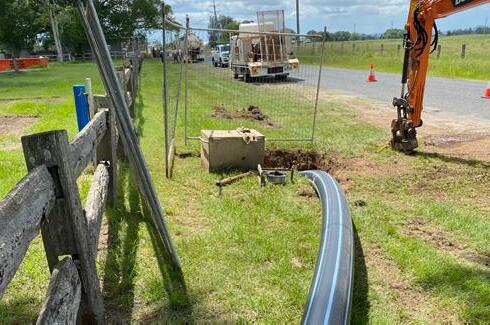

PICTURED: High Density Polyethylene (HDPE) pipeline is fed underground (left) and connected (right) in sections, to replace the old mains to Tucabia along Coldstream Road.
A new 2.7 kilometre section of water mains has been installed to prevent costly repairs and potential interruption to water supply to Tucabia.
The new high-density plastic line has been installed alongside Coldstream
Road from Ulmarra, to replace the aging and brittle water mains that in parts ran under the road surface. The work was done in the lead-up to an upgrade of Coldstream Road, as it was anticipated that heavy machinery used for the road upgrade would be
likely to damage the old pipeline. Relocation of the water mains away from the road will also prevent potential damage to the new road and make repairs easier in the case of any future failure of the pipeline.

Planning has been done and a contractor chosen to put a new roof on the Maclean water reservoir.
The old roof is starting to rust and needs to be replaced to protect drinking water for thousands of residents in Maclean, Gulmarrad, Yamba and surrounds.
The new roof will be aluminium, which is lighter and more resistant to rust than galvanised steel. Its more than twice the size of your average house roof and will cost around $300,000.
The inside of the 4.5 megalitre concrete tank will be emptied and get a good clean-out while the roof is off.
Thousands of tonnes of rock have been packed into the riverbank and hundreds of native grass seedlings planted, to help protect the levee wall at Grafton.
The work was done to repair damage to several sections of the bank of Clarence River between Alice and Queen streets, where fast-flowing water during the 2022 floods had begun to wash away the soil.
More than 2000 tonnes of rock were carefully placed by an excavator operator into the riverbank to complete the engineer-designed works, and hundreds of Lomandra longfolia seedlings planted to prevent further erosion.
No fancy underwater cameras or sensors were used to help the excavator operator see where to place rock under the water’s surface. Instead, they were guided by ‘feel’ and experience to know what their eyes couldn’t tell them.

An excavator operates from a barge on the Clarence River, to place tonnes of rock into the bank to protect the levee.

A hardy Aussie grass first used by First Nations people for food and medicine has now been used to protect the banks of the Clarence River from erosion.
Lomandra longfolia is a common, fast-growing native plant that will grow in almost any soil type or climate. For thousands of years its leaves have
been used to weave baskets, its roots to make medicine for insect bites, and its berries eaten as bush tucker.
But it’s the long, fibrous root system behind its modern use in erosion control. This dense network of tendrils grows as far as a metre down into the soil, holding particles tightly together to stop them from being washed away.

Hines Construction Manager Paddy Barber explains the process of putting down a layer of concrete to provide an even basis for the reinforced slab, in preparation for installation of the new outdoor Olympic pool (main image). All images taken on March 22, 2024. Formwork for the balance tanks that will support circulation of water through the indoor pools (top right). Work on the foundations for the indoor centre (middle right). The amenities block has been gutted in preparation of refurbishment (right).
La piscina sono in arrivo dall’Italia!
In case you don’t read Italian, here’s the exciting news in English: The pools are on the way from Italy!
That’s right – the new engineered modular pools for the Regional Aquatic Centre are now on a boat from the factory in Italy, on their way to be assembled onsite in Grafton.
Meanwhile, the construction contractor has been busy preparing the Turf Street site for installation of the pools when they arrive.
Much of the foundation work has been completed for the new outdoor Olympic pool and the indoor centre with two heated pools.
Demolition crews smashed up the old steel-reinforced concrete pools with a 26-tonne excavator, then crushed it to be reused onsite rather than going to landfill. The grandstand and pump buildings were dismantled and the steel recycled.
The project remains on track to be open by Christmas 2024.



Assembling stainless steel and PVC prebuilt panels onsite is much faster than using traditional concrete and tiles
Cost-effective and highly durable
Designed to look incredible
Proven track record – used for pools at six Olympic Games, including Paris 2024
Lower greenhouse gas emissions
Purpose-built modern facility now under construction
The old Treelands Drive Community Centre was less than ideal for many users, with tiny offices, a single large space linked to the kitchen, pokey toilets and only a handful of parking spaces.
The building was designed and built in the 1990s for a completely different purpose – to provide aged care services as a Home and Community Care Centre.
The old building was demolished in January 2024, and construction of the new purpose-built Treelands Drive Community Hub is now underway that will feature up to eight rooms that can be reconfigured for different users, a library, an art exhibition space, a youth space, modern accessible toilets, and a new kitchen.
A new 43-space carpark is also being built, including provision for three electric vehicle charging stations.
The $18 million Treelands Drive Community Hub (Yamba Community Precinct) is being built thanks to an $11 million grant from the Australian and NSW Government through the Bushfire Local Economic Recovery Fund
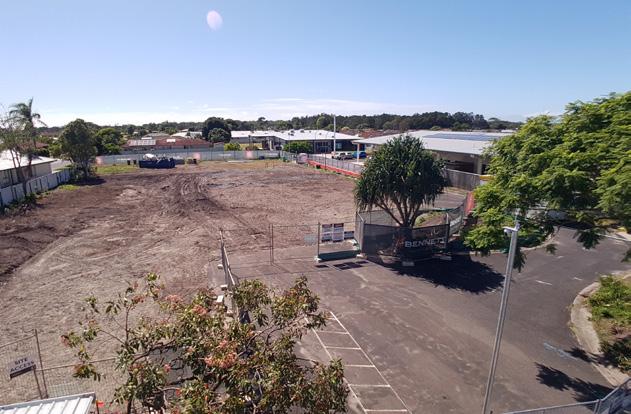


PICTURED: The old Yamba Community Centre has been taken apart and materials reused or recycled, to make way for a new facility that will better suit the needs of the community.
Demolition complete
Topsoil stripped
Excavated material removed from site
Fill imported and compacted
Inground plumbing and electrical installed
Concrete slab work commenced
Purpose-built for the whole community
Room size and layout can be customised to suit users.
43 parking spaces including EV charging
Fully accessible modern amenities
Includes library, youth space, art gallery
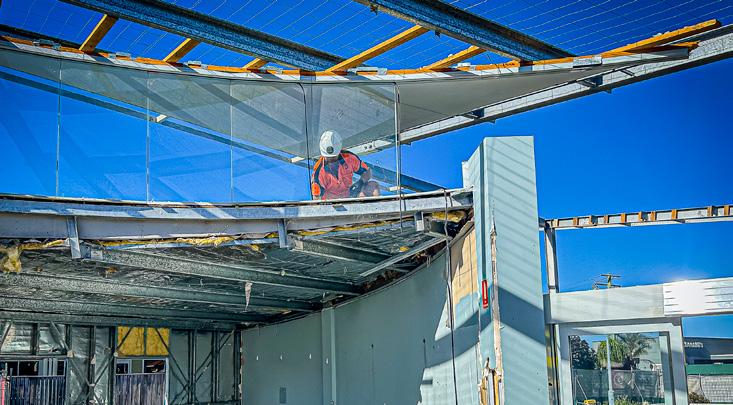
PICTURED: A
specialist demolition company carefully dismantes the former Yamba Community Centre in Treelands Drive, to ensable materials to be reused or recycled.
CREDIT: Goat Collective

Community centre lives on through reuse and recycling
Almost every part of the old Yamba Community Centre has found a new home, with components reused or recycled to ensure minimal impact on the environment.
To achieve this, a specialist demolition company was recruited to carefully dismantle the old building, rather than the traditional “munch and crunch” knock-it-down approach.
Much of the work was done by hand, right down to undoing the steel frame to keep and reuse the bolts.
As a result, steel framing, doors, external cladding, roofing, windows, toilets, taps and sinks have been
reused in new homes or renovations. The concrete slab, footings, paths and asphalt car park have also been reused in construction projects.
Even most of the materials that couldn’t be directly reused have been given a second life. Like the internal gypsum plasterboard walls, which have been recycled as an agricultural product used to improve soil. Metals and glass that were unsuitable for reuse were also sorted and recycled. This approach resulted in just three per cent of demolished material going to landfill.


97% WASTE-FREE
REUSED: 91.8%
RECYCLED: 5.2%
DISPOSED: 3%
ADVANTAGES OF REUSING MATERIALS
No power required for production or reprocessing
No need for mining or forestry for raw materials
Nothing going to landfill
Parking will be a breeze when you take the kids to soccer in South Grafton or head to the oval to get in your steps for the day, thanks to the new 144-car space sealed car park.
The new carpark will be great for carnivals and big competitions where we host teams visiting from other towns and cities, with plenty of car parks for visitors as well as space for three busses to park and turn around.
The new car park will be safer than parking along Rushforth Road as it’s away from traffic, and you won’t have to trudge through muddy puddles in wet weather.

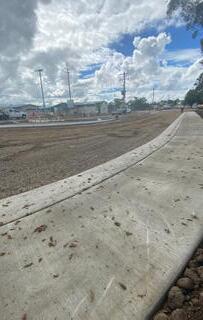

Night events at the Maclean Showground like the annual agricultural show and the Lawrence Rodeo are being lit up like never before thanks to brand-new LED lighting.
The 38 brighter more efficient LEDs replaced the outdated sodium vapour lights, providing better light across more of the showground to illuminate sideshow alley, the stables, and the arena.
Competitors in the recent Lawrence Rodeo were the first to enjoy the brighter and clearer quality of light, which made it safer to compete and easier for spectators to keep a close eye on the action.
The existing light poles were reused because they’re in good condition and suitably located to enable the new lights to cover the whole showground.
Come along to info session to find out
To help people decide whether being a Councillor is the right for them, a series of information sessions have been organised.
The sessions will provide an overview of how local government works and the role of a Councillor within it, as well as the opportunity to discuss expectations and challenges.
They will also delve into how council meetings operate and look at aspects relating to the code of conduct and conflicts of interest.
COUNCILLORS MAY CONTRIBUTE A RANGE OF SKILLS AND ABILITIES, SUCH AS:
Social justice advocacy
Financial management
Effective and influential communication
Negotiation and conflict resolution
Passion for the local community
Service delivery experience
Economic development


PICTURED: Could you see yourself filling the seat of a Councillor at future council meetings? Have your name added to the history of representation on Clarence Valley Council? Come along to one of the information sessions in July.
Scan or tap the QR Code to find out more about becoming a Councillor

SAVE THE DATES
CANDIDATE INFORMATION SESSIONS
2 JULY Maclean Council Chambers
16 JULY Grafton Council Chambers
18 JULY Online via TEAMS

ARE YOU ENROLLED TO VOTE? Scan the QR Code to make sure you’re enrolled to vote for the local government elections in September.
Aneika Kapeen takes top honour
Mudyala Aboriginal Corporation
CEO Aneika Kapeen has been awarded the 2024 Citizen of the Year Award for her dedication to helping people in need.
The proud Yaegl woman has been described as an “inspirational role model” by her small team that works year-round to educate and support people of all ages, abilities, backgrounds and genders.
The award recognises Aneika’s commitment and personal sacrifice to make a real difference in the lives of countless people including the financially disadvantaged, those at risk of homelessness, and those affected by natural disasters.
The awards were hosted by Clarence Valley Council in Yamba on January 25 and were presented by Mayor Peter Johnstone and Clarence MP Richie Williamson.


PICTURED: Left, 2024 Citizen of the Year Aneika Kapeen (centre), with MP Richie Williamson (left) and Mayor Peter Johnstone (right).
Below from left, Westpac Rescue Helicopter Grafton Volunteer Support Group, Aiden Really and Sally Rogers.


COMMUNITY ACHIEVEMENT: Westpac Rescue Helicopter Grafton Volunteer Support Group. The group has hosted high teas, barbecues and barefoot bowls events since 2012 to raise more than $134,000 to support the life saving work of the rescue helicopter.
YOUNG CITIZEN OF THE YEAR: Aiden Really. Aiden, 13, has been passionately working to raised funds to help cancer patients for the past two years after losing his own father to the disease.
LOCAL HERO: Sally Anne Rogers. The Happy Paws founder has dedicated many years to rehoming unwanted cats and dogs and continues to empower people of all ages and backgrounds to connect and grow through volunteering with the organisation.
Pauline Journet was one of 17 new Australians to make their formal commitment to the nation in an official ceremony at Yamba on January 25. The young French backpacker initially had no intention of moving to Australia. Then she met and fell in love with Rodney from Maclean, and they spent
the next two years travelling the nation together.
They later married and settled down in Maclean – the place Pauline now calls home.
“I love the river, the greenery, the peace and quiet. I’m from the country in France, so I value these things,” she said.



PICTURED: Solar panels (left) and generators (right) have been installed at three remote community halls to ensure they have power during emergencies.
Solar and generator systems have been installed at Coaldale, Nymboida and Dundurrabin community halls to ensure they can maintain power supply during natural disasters such as bushfires, floods and severe weather events.
The backup power systems feature solar panels and hybrid inverters, battery storage systems and backup diesel generators.
Solar panels and an inverter have also been installed at the Calliope community hall so it too can enjoy lower electricity bills and a smaller carbon footprint.
The projects were funded by the NSW Black Summer Bushfire Recovery Grants Program.
KEY:
kW – kilowatts (1000 watts)
kVA – kilo-volt-amperes (1000 volt amps)
COALDALE
10kW
GRID CONNECT
7.5kW
HYBRID INVERTER
10kW
BATTERY STORAGE
6.5kVA
GENERATOR
CALLIOPE
7.4kW
GRID CONNECT
6kW INVERTER
NYMBOIDA
13.2kW
GRID CONNECT
10kW
HYBRID INVERTER
22.4kW
BATTERY STORAGE
6.5kVA GENERATOR
DUNDURRABIN
7.92kW
GRID CONNECT
6kW
HYBRID INVERTER
9.5kW
BATTERY STORAGE
8kVA GENERATOR



PICTURED: BlazeAid volunteer co-ordinators Greg and Karen Noble and volunteer Charlie Webster (orange vests) help Nymboida livestock farmer Reece to repair his fire-damaged fencing.
HOW TO HELP OUT: BlazeAid is always looking for volunteers to help in disaster recovery efforts in locations around Australia. Scan or tap the QR code to find out more.
Experience over recent years has shown us how severe weather conditions can lead to extreme bushfires, impacting even those areas we thought were safe like grassland and cropping land.
To ensure future housing considers suitable measures to minimise risks, Council has worked with experts to use the latest real-world data to update
BlazeAid volunteers have been hard at work since Australia Day helping dozens of Nymboida farmers repair kilometres of fences damaged by flood and fire, with support from Council.
Many farmers have struggled to find the time to fix fencing or the money to pay someone to do it, including Reece, who has been working side by side with BlazeAid volunteers to replace posts burned out by bushfire in 2019.
Reece has a young family and like many farmers works a second job to earn a living, so having some extra hands-on deck to finally fix his fences was much appreciated.
Hands like those of Charlie, a semi-retired mining worker who jumped at the chance to come down from Queensland to help out.
Charlie said BlazeAid had helped a friend of his in the wake of the 2016 floods that devastated south-east Queensland.
“He was in a bad way, had lost hope, but having the volunteers form BlazeAid come and help him out showed him a light at the end of the tunnel,” he said.
Council has been assisting with the cost of running the BlazeAid volunteer base camp at the Nymboida Canoe Centre. Landowners have to pay for costs of all materials.
bushfire prone land mapping.
The Bush Fire Prone Land Map is a trigger to ensure bush fire risk is considered during the development application process.
The draft map is currently in the process of getting the final tick of approval from the NSW Rural Fire Service before it comes into effect.

Weddings, soup and damper nights, morning teas and Easter and Christmas parties will be held at the Jackadgery Community Hall for many years to come thanks to a major restoration.
The much-loved but dilapidated Jackadgery Hall has had a complete makeover to the tune of around $320,000, funded by the NSW Black Summer Bushfire Recovery Grants Program.
It has been visually transformed with
new paint, awnings and window trim, but the work goes well beyond making the hall look good.
The entire building has been lifted off the ground and restumped to give it better protection against termites, with new ramps built to ensure easy access for everyone using the hall.
The kitchen has been done up to make catering for events much easier, and the toilets have also been given a spruce up and access improved.



Work has commenced on the latest $1.5 million annual sewer relining program, to renew more than three kilometres of aging pipes across Grafton, South Grafton, Maclean and Yamba.
The innovative process involves installation of a flexible tough plastic lining to extend the sewer lines life by an estimated 100 years, without the disruption and expense of excavation and replacement.
The work is being carried out by an expert contractor engaged by Council.
Last year a total 4.4 kilometres of old sewer was renewed, after the program’s ongoing budget was doubled to fast-track improvements on the aging network.
The relining program is funded by rates and charges, through the water and sewer fund.
Cost and time effective
No need for excavation
Minimal red tape
Extends pipe life by around 100 years



PICTURED: Above, clockwise from top left, a cable CCTV line is used to inspect sewers to ensure they are clean and clear prior to lining. High pressure water jetting is used to clear any material from the sewer. Structural PVC is rolled out off the back of a truck into the sewer, where it is expanded to form a tight-fitting durable lining.
A new resource has been made available by Council called ‘Your Go Electric Action Plan’, to empower individuals to take action towards a greener more sustainable future.
The Plan provides a do-it-yourself guide to help you decide what you can do and when, to move towards more sustainable energy choices. It has an emphasis on choosing electric options, as power providers continue to transition to renewable energy sources.

It was created as part of Council’s Community Energy and Emissions Reduction Strategy, to encourage adoption of energy efficient technologies to reduce emissions.
Scan the QR Code to download the free template for your own Go Electric Action Plan

PICTURED: Coordinator Fleet and Procurement, Darren Tayor, with one of our 32 hybrid petrol-electric cars.

To gauge public sentiment on electric vehicles, we surveyed Clarence Valley residents and received 101 replies
WHAT WOULD YOUR ANSWER BE?
QUESTION 1: Would you consider purchasing an electric vehicle?
YES: 35 NO: 30
ALREADY HAVE ONE: 19
MAYBE: 17 YES: 63 NO: 31
QUESTION 2: Should Council advocate for more public EV charging stations?
UNSURE: 7
Council has 32 hybrid vehicles in its fleet with another 12 on their way, as part of a commitment to choose energy efficient technologies and reduce emissions.
It’s all part of the strategy to reduce carbon emissions across our operations, which has also included installation of onsite solar power generation and storage at the Rushforth Road works depot to prepare for acquisition of fully electric vehicles.
Scan or tap the QR Code to check out our Community Energy and Emissions Reduction Strategy and Greenhouse Gas Emissions Reduction and Renewable Energy Targets Report.
Six high-tech drones have been acquired, with impressive new capacity that will help battle weeds, save our endangered koalas, and prevent pollution.
One of these eyes in the sky features a camera that can see in five different wavelengths, beyond what can be perceived by the human eye. It can be used for a wide range of purposes, including detection of weed outbreaks and leaks from onsite wastewater systems.
Another of the new drones can be programmed and flown with little input from the pilot, to map large areas with pinpoint accuracy using advanced positioning technology.
This mapping can then be used by our new specialised spraying drone, to target hard to reach weed infestations with incredible precision.
The mapping drone can also be fitted with a range of specialised cameras, such as a thermal camera to detect and map koala populations.
Three new compact mini drones were also bought, which require minimal training to use and include a highquality onboard video camera - ideal for activities like weed inspections.
This new tech is set to revolutionise how we undertake a range of operations, capturing more data from the sky in a few hours than could be achieved on the ground in weeks or even months.




Weeds like Lantana can rapidly turn productive farms into virtual wasteland, so Council is supporting local primary producers to help fight these fierce invaders.
The weeds teams have targeted pest species along more than 170 kilometers of roads and waterways, to help prevent their spread to nearby farms.
Weeds targeted included the notoriously invasive Lantana, and less well-known pest species such as Black Locust, Mysore Thorn, Leucaena and Cockspur Coral Tree.
Much of the work was done on the strip of public land between Big River Way and the Clarence River, from
Glenugie to Maclean, where teams will now plant thousands of native trees.
Teams also helped get rid of an infestation of a woody American ornamental called Groundsel Bush, on farmland south of Maclean.
Water Hyacinth and Salvinia were targeted on creeks and dams in Waterview Heights, Swan Creek and Alumy Creek. These pests can choke waterways and destroy the quality of water relied upon for livestock.
Follow-up inspections are planned at locations where control measures were carried out, to ensure early detection of any new seedlings and prevent reinfestation.
Lantana has been rated in the top 10 of Australia’s worst invasive species, infesting millions of hectares of land, devastating farms, and poisoning livestock. The weed can quickly take over if not controlled.
PICTURED: Our weed control operators working along Big River Way as part of the State Government funded Early Needs Weed Management Project.
Has a new plant appeared at your place and you’re not sure if it’s a weed?
Take photos of the whole plant then close-ups of leaves, flowers and any seed pods
Scan the QR code, or go to www.clarence.nsw.gov.au/ Forms/Report-it, to upload them with any additional info.
A weeds officer will check it out and provide advice
Scan or tap the QR Code to get help on plant identification.

Scan the QR code to join the North Coast Weed Action Group facebook page, to keep up to date with the latest info on weeds management.

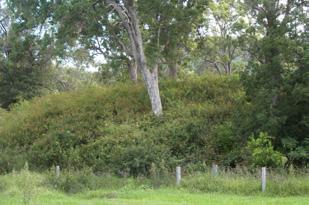

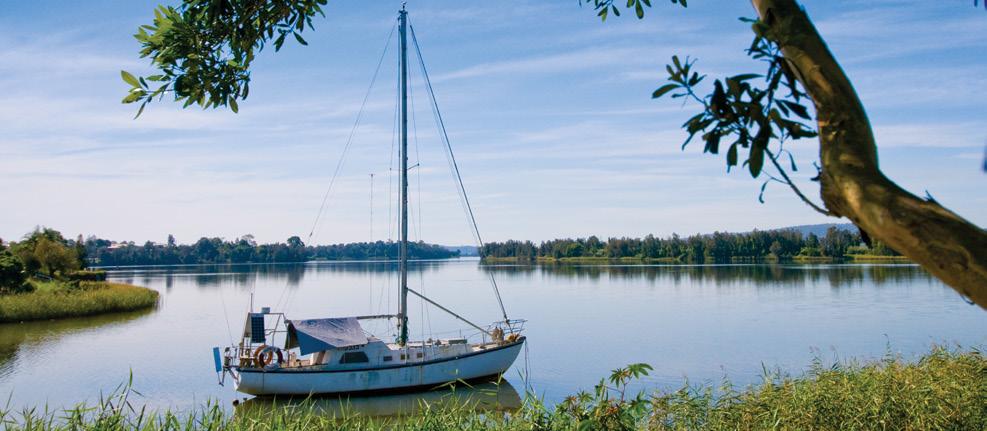
The Lawrence community put forward its ideas for the future of its village –now these ideas have been officially adopted as the Lawrence Community Economic Development Plan.
These ideas, gathered as part of community workshops and surveys, have formed the basis of the 10-year plan for the village. It was formally adopted in March 2024.
THEY INCLUDED:
Improve roads, footpaths, cycleways, and walking trails
Enhance parklands and access to the river
Create signage to guide visitors and tell local stories and history
Form a Youth Strategy to engage young people in the community
Support low-impact tourism and river-based events
Promote the ferry as a unique visitor experience
Support the work of already active community groups.
The plan aims to provide a comprehensive framework that outlines key strategies and initiatives to stimulate economic growth and enhance community well-being in the Lawrence area
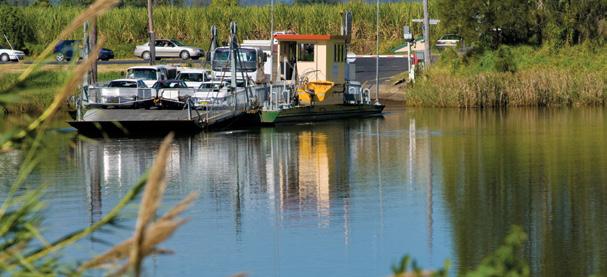
have now been adopted in a 10-year economic development plan for the village.

Scan or tap the QR code or visit the Clarence Valley Council website to view the Lawrence Community Economic Development Plan.
More than 300 turned out to enjoy a morning of music and connection at the Grafton library on March 13, for the inaugural On Record Seniors Week celebration.
The usually quiet library was brought to life with the sounds of singing, bagpipes, ukeleles and dancing as part of the program showcasing the talents of our older residents.
Acts included the Good Vibes Choir, Tempomentals, Ukettes, the Scottish Piper, and Grafton Line Dancers.
The event was not only an opportunity for seniors to connect with one another and enjoy the talents of their peers – a range of organisations were also on hand to provide information such as Services NSW, aged care providers, and the Country Women’s Association.





Performing at the Tamworth Music Festival was a huge moment for Ellie Metcalfe, but it may not have ever happened if it hadn’t been for Youth Week’s Live ‘N’ Loud at Your Library.
The 18-year-old country music artist was among a huge program of young local musicians planned to take to the stage in the Grafton library’s carpark on April 18 to celebrate Youth Week 2024.
Ellie is a regular fixture at the local event, which has exploded in popularity from its humble beginnings in a small library meeting room in 2016, to a festival-style show that packs the carpark with hundreds of fans.
Live ‘N’ Loud gave Ellie her first taste of public performance when she took to the stage four years ago as a terrified 14-year-old – a gig that paved the way to her dream of playing at Australia’s premier country music festival.
“If I didn’t perform at Live ‘N’ Loud I wouldn’t have had the confidence sing in front of people like I have for the past two years at Tamworth,” she said.
“It definitely creates an opportunity for young local artists to experience what it’s like to be on stage in front of a crowd, and it’s great to showcase the talent that is here.”

All Youth Week events are drug, alcohol and vape free. Under 12's must be accompanied by a responsible adult. All events are free and bookings are essential.
Almost 300 young people were getting active, feeding their creativity, and connecting with others across 28 activities and workshops held throughout the Clarence Valley in January.
The school holiday program was organised by Council in collaboration with nine community organisations.
It is part of Council’s commitment to support activities for and engage with younger residents throughout the area.
SCHOOL HOLIDAY ACTIVITIES INCLUDED:
Laser skirmish
Screen printing
Paint marker art
A cultural connection day
Box fit training
Surfing lessons
Graffiti art
Wood burning
Impaired driving simulation

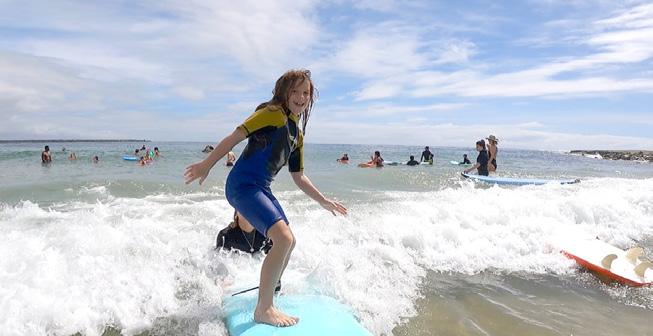


This Strategy aims to enable the workforce to fulfil its commitments to the community by ensuring the workforce has the capacity, capability, skills, and sustainability to deliver outcomes in line with Council's Delivery Program and Community Strategic Plan.
The Strategy is reviewed annually as part of the Resourcing Strategy, which is part of the Integrated Planning and Reporting Framework.
Central to this Strategy is the development, implementation, and investment in a Leadership Development Framework. One key part of this Framework is the LEDA leadership course.
LEDA is a unique journey that draws on leadership expertise and academic research, empowering participants to cultivate strong leadership behaviours from the ground up every day. The program's innovative approach focuses on a single skill, creating behaviour change, and building habits, starting with self-awareness and progressing to self-management and relationship management.
This year, 14 participants are in

the LEDA program. They follow a successful 2022/2023 group of eight participants who completed the program.
More than half – 57 per cent – of this year’s participants this year are female, which drives a strong presence of gender equality of within the workforce.
Rachel Selby is among those participating in LEDA, after moving into a people manager position from the senior officer role.
“The program is flexible so I can complete in my own time. It offers
During Council’s Coordinator Forum held on Thursday 7 March, a diverse group of staff took pause to reflect and celebrate International Women’s Day (IWD), an annual global celebration commemorating women’s achievements and contributions worldwide.
Council’s Corporate and Community Director, Alex Moar said Council had been working over recent years to develop policies and introduce training and development opportunities
PICTURED: People Manager Rachel Selby is among the 14 Council staff members developing leadership skills through the LEDA program.
CREATING STRONG LEDAs
14 PARTICIPANTS
57% FEMALE
theoretical and hands-on experiences and provides the underlying psychological concepts of leadership, as well as the opportunity to discuss improvement strategies with other leaders,” she said.
Almost HALF Council’s leadership team is female – DOUBLE what it was three years ago
that promoted gender equality and inclusivity in the workplace.
“This year’s theme for IWD which is ‘Inspire Inclusion’, and it’s inspiring to see that women represented 41 per cent of the 34 coordinators at the
forum, and that the percentage of females in our leadership team had increased from 23 per cent to 46 per cent in just under three years,” she said.
“We strive for inclusion because ultimately when we all work together it benefits everyone in our community, and it’s exciting that we have such a diverse team of people working across the organisation to help deliver the essential services and facilities our community relies on.”
Moving from a career in the Defence Force to work with Clarence Valley Council has enabled Keely PowerCasson to have everything she wanted in a job.
Keely returned home to Grafton in May 2023 to take on a customer service position with Council, after five years away working in warehousing and distribution for the Australian Army at Townsville.
The new job not only enabled her to be once again surrounded by family – local government had a reputation for providing job security. Now almost 12 months on, Keely said working for Council had proven to be highly rewarding.
“Having flex time enables me to have a great work-home balance and be there for my young daughter when there are appointments or events at school,” she said.
“Customer service is a great team to be part of, really supportive. And I’m now undertaking further professional development to specialise in answering rates enquiries – it’s a well-structured training program, and I’m enjoying taking on lots of new knowledge.”
Keely said she had been impressed


by initiatives such as the STRIVE awards that recognised outstanding staff achievement, and the Veterans Employment Program introduced in late 2023 to help attract former armed servicepeople and capitalise on the skills they offered. She added that it was also reassuring to know she was supported in her role through development of organisational policies and documentation, such as the new Customer Experience Charter.
PICTURED: Keely PowerCasson helping a customer over the phone with a rates enquiry.
Customer service is a great team to be part of, really supportive. And I’m now undertaking further professional development to specialise in answering rates enquiries – it’s a wellstructured training program, and I’m enjoying taking on lots of new knowledge.
Experience in the military provides people with extensive skills that make them ideal for a position within local government, such as abilities in leadership, teamwork, initiative, accountability and communication. To help attract ex-services personnel and help prospective employees understand how their military skills translate to a career with Council, we have adopted a Veterans Employment
Program.
The program also gives guidance to veterans on how best to communicate their transferable skills in the job application process, including a grade guide that translates the skills of various ranked armed services positions to their equivalent position and level within Council.
Our hiring managers also undertake
regular training and education on how the skills of veterans can be utilised in various operations of Council.
If you have military experience and want to find out how your skills may be used for a career in local government, scan the QR code on this page. For further information or help with applying for a job with Council, email us at people@clarence.nsw.gov.au
Eight young trainees and apprentices have kickstarted promising careers right here in the Clarence thanks to a new Council initiative.
The program is called Grow Your Own, and that’s exactly what it intends to do –take action to grow the local area’s skilled workforce, amid a nation-wide skills shortage.
The new trainees and apprentices started their new jobs with Council in January and February this year, where they will develop real-world skills to further their careers and provide services essential to residents and businesses.
Round 1 of Grow Your Own attracted more than 100 applications.

Ann-Belle Lacey
JOB: Trainee stores
CORE SKILLS: Stock management, organisation, safety.
AGE: 16
HOME TOWN: Pillar Valley
WHY DID YOU APPLY: Opportunity to leave school early and start career

Flynn Hanson
JOB: Apprentice plant mechanic
CORE SKILLS: Mechanical diagnostics and repairs, safety.
AGE: 17
HOME TOWN: Grafton
WHY DID YOU APPLY: Not academically focussed, opportunity to enter workforce
 Shayla Graham
Shayla Graham
JOB: Trainee organisational development
CORE SKILLS: Data analysis, resource and project management, communication.
AGE: 16
HOME TOWN: Ulmarra
WHY DID YOU APPLY: Opportunity to leave school early and start career

Toby Makings
JOB: Apprentice fitter
CORE SKILLS: Mechanical, engineering, technical
AGE: 18
HOME TOWN: Grafton
WHY DID YOU APPLY: Expand on skills already learned working in fabrication

Miah Bell
JOB: Trainee customer service
CORE SKILLS: Communication, networking, research.
AGE: 21
HOME TOWN: Grafton
WHY DID YOU APPLY: Change of career from bush regeneration

Layla Stevens
JOB: Trainee stores
CORE SKILLS: Stock management, organisation, safe work.
AGE: 21
HOME TOWN: Grafton
WHY DID YOU APPLY: Change of career from hospitality

Hayden Riley
JOB: Apprentice plant mechanic
CORE SKILLS: Mechanical diagnostics, repairs, safety.
AGE: 17
HOME TOWN: Palmers Island
WHY DID YOU APPLY: Pathway into mining industry career

Hayden Biele
JOB: Apprentice bridge carpenter
CORE SKILLS: Teamwork, construction, highlevel safety
AGE: 16
HOME TOWN: Grafton
WHY DID YOU APPLY: To pursue a good career
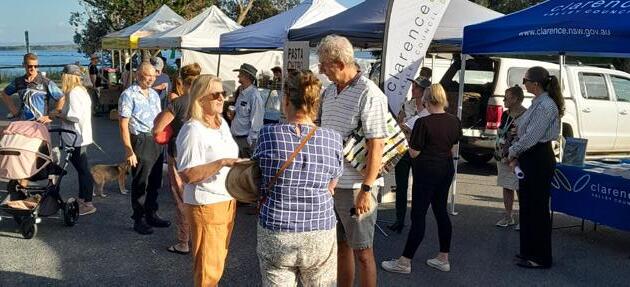
Public buildings and the water network are being maintained to a high standard, but there are some things that could be done to improve on the paperwork side of things, according to the latest operational audit.
Council has a regular schedule of audits each year, where an expert consultant is recruited to look over operations for an outside opinion on what is being done well and what could be improved.
The leadership team was out and about at the Yamba Farmers Markets at the end of February, to hear directly from residents on the issues that were important to them.
Dozens of marketgoers chatted throughout the morning with our team that included the General Manager and leaders across all areas of Council responsibilities.
A wide range of issues and concerns were raised for discussion, including road maintenance, weeds, feral cats, public information on museums and

tourism, and rates and charges.
Staff were able to help a Yamba resident report an issue with a tree on public land; remove a rogue apostrophe on an electronic sign thanks to an observant former school teacher; and advise a resident on how they could make a submission to Councillors on concerns about potential future mining in the area. Two community leadership engagement sessions were also held as part of events celebrating Seniors Week and Youth Week.
In the latest audit, they looked at how Council is managing its ‘water assets’ – the network of pipes and pumps that gets water from the river to your tap; and ‘building assets’ – such as galleries, libraries, works depots and structures at playgrounds and sports fields.
The conclusion was that overall, these assets were well maintained but there are opportunities to improve detail and consistency in related record-keeping.
The audit also found that Council could better utilise some features of the new systems management technology called Connected Intelligence Anywhere (CiA).


The Coutts Crossing Croquet Club has caught the eye of the NSW Governor, who invited members to Government House for an honorary exhibition match in February.
The invitation followed a visit last year to the Coutts Crossing Croquet Club’s courts, by the NSW Governor, Her Excellency the Honourable Margaret Beazley AC KC.
The courts are managed by the club as part of its lease agreement with Council – one of many such arrangements reaping benefits for sporting and social clubs around the Clarence Valley.
These partnerships empower community groups to undertake activities that reduce social isolation and help people stay healthy.

There are so many organisations doing great work with our young people, so Council’s Youth Officer co-ordinates a meeting to get all these groups together once a month to share their knowledge and ideas.
It’s called the Clarence Youth Network, where the sharing of ideas, information and experience helps groups to work together towards their common goal.
In February, the group hosted a workshop with the boss of the top youth organisation in the state – Kate Munro, of Youth Action.
She shared her expertise on Evidence Based Practice, helping around 32 local youth workers to expand their understanding of how to gather the best possible information, and use it to improve what they do.
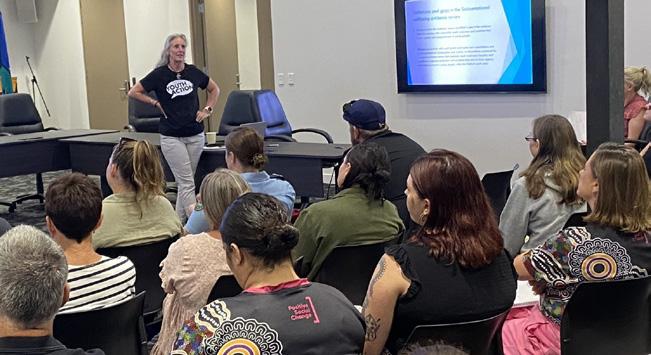
The creative talents of local photographers have been recognised through the annual InFocus competition. More than 120 entries were received across four categories for the awards. The winners were announced in February, each taking their share of the $2500 prize pool. Winning entries have been published in the official 2024 Plunge Arts and Culture Festival program, created to promote the month-long celebration throughout April.





CLOCKWISE FROM TOP RIGHT: Clockwise from top right: ‘There has to be somebody out there…’, by Todd Brewer, winner People category. ‘Ocean Cascade Angourie’, by Gary Nichols, winner of the Landscape category. ‘Cleanfreak – Eastern Osprey’, by Patrick Keeling Booth, winner Environment category. ‘Great Night Grooving on the Grass’, by Joy Hayman-Ward, winner Community category. ‘Do You Come Here Often?’, by Theresa Haley, winner Plunge category